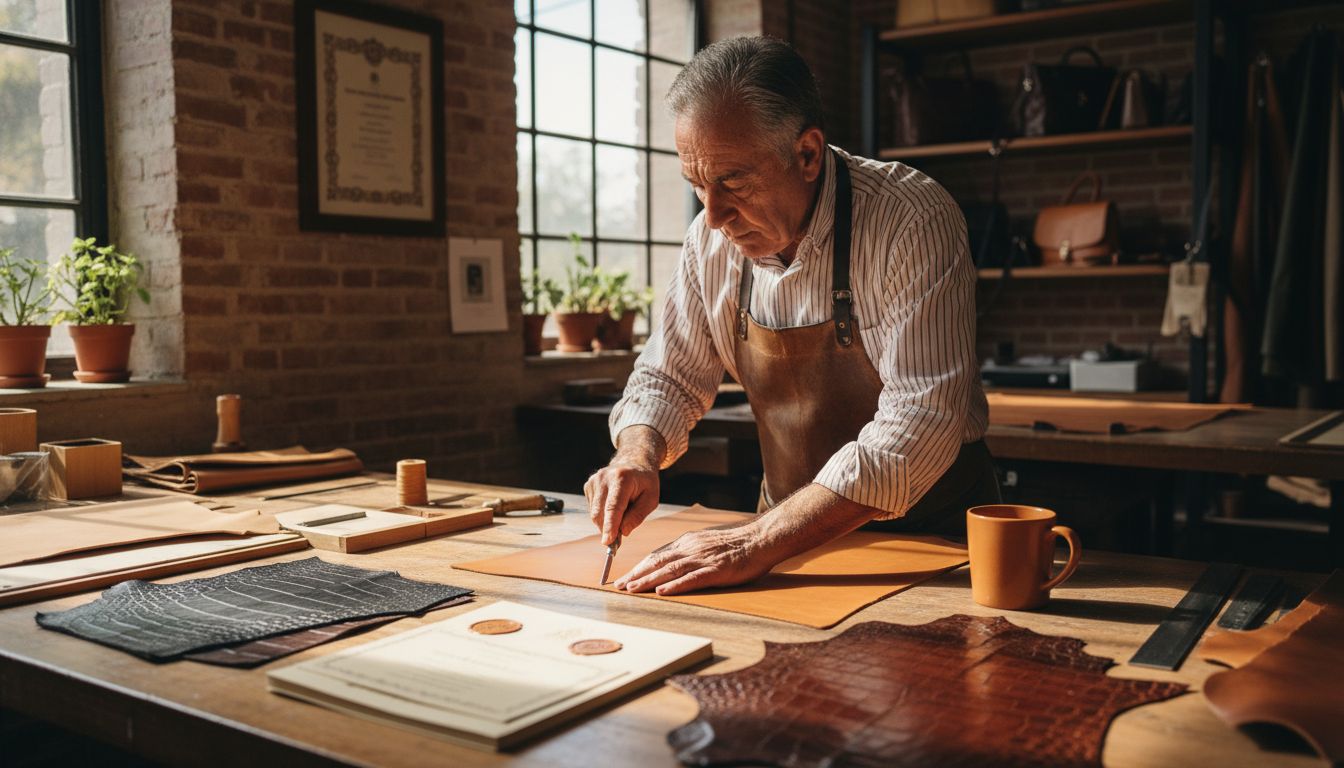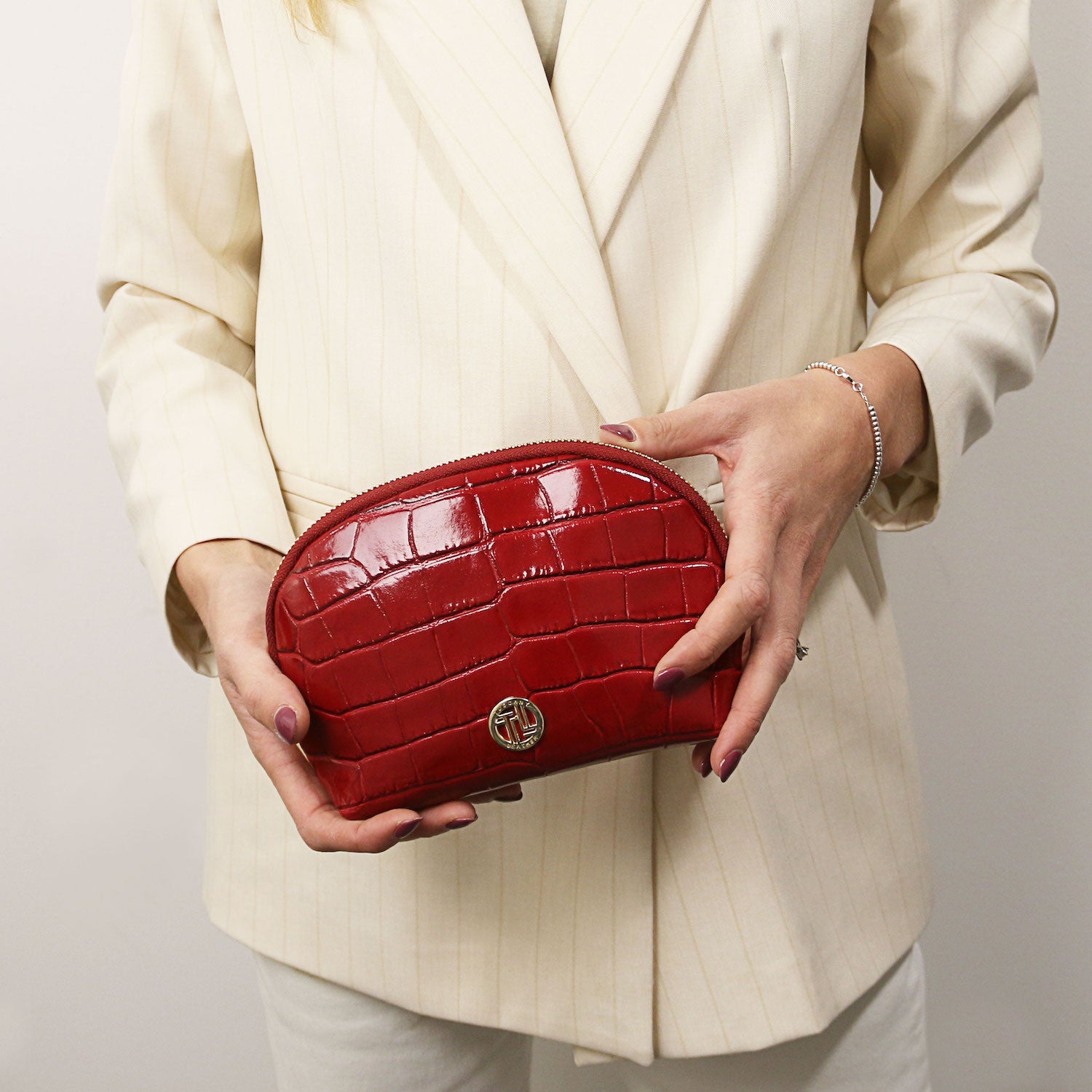
The Essential Guide to How Italian Bags Are Made
Share
Did you know that over 80 percent of luxury leather goods are crafted in Italy, making it a global leader in fine handbags? Italian bags stand out for their rich heritage, remarkable materials, and attention to detail that have shaped generations of artisan workshops. This tradition creates more than stylish accessories, telling stories of artistry and passion while offering a glimpse into a world where quality comes first and style truly lasts.
Table of Contents
- Defining Italian Bags and Craftsmanship
- Types of Italian Bags and Leather Used
- Traditional Techniques in Italian Bag Making
- Quality Standards and Authenticity Marks
- Ethical Practices and Sustainability in Production
Key Takeaways
| Point | Details |
|---|---|
| Artisanal Heritage | Italian bags are a symbol of rich craftsmanship, originating from Florence, where skilled artisans use generational techniques to ensure quality. |
| Diverse Leather Types | Various leather types, such as full grain and nappa, provide unique characteristics and serve distinct purposes in bag making. |
| Quality Standards | Authentic Italian bags feature meticulous quality checks, including hand-finished edges and artisan signatures, reflecting a commitment to excellence. |
| Sustainability Practices | Modern Italian craftsmanship integrates sustainable methods, focusing on eco-friendly production and support for local artisans, enhancing both ethical and environmental awareness. |
Defining Italian Bags and Craftsmanship
Italian bags represent more than a fashion accessory - they embody centuries of artisanal heritage and uncompromising quality. At the heart of this tradition lies Florence, the historic epicentre of leather craftsmanship where generations of skilled artisans have perfected their techniques with an unwavering commitment to excellence.
According to research from the Accademia Riaci, Florence has been instrumental in nurturing a leather industry defined by meticulous attention to detail and superior manufacturing processes. These artisans do not merely create bags; they transform high-quality leather into functional works of art. The craftsmanship involves intricate techniques passed down through family workshops, where skills are learned through direct mentorship rather than standardised training.
The legacy of Italian bag making can be traced back to historic institutions like Valigeria Franzi, founded in Milan in 1864. Explore the history of Italian handbag making to understand how these pioneering businesses supplied royalty and nobility, setting unprecedented standards of quality. Key characteristics of authentic Italian bags include:
- Full-grain leather selection
- Hand-stitched construction
- Generational artisan techniques
- Minimal machine intervention
- Personalised design approach
True Italian craftsmanship transcends mass production, focusing instead on creating timeless pieces that reflect individual skill, cultural tradition, and an profound respect for materials.
Types of Italian Bags and Leather Used
Italian leather bags represent a sophisticated world of diverse materials, each telling a unique story of craftsmanship and aesthetic precision. Leather selection is fundamental to creating exceptional handbags, with artisans carefully choosing materials that balance durability, texture, and visual appeal.
According to Tuscany Leather, Italian bag makers work with an impressive range of leather types, each offering distinctive qualities. Full Grain leather stands out as the highest quality, preserving the natural markings and strength of the hide. Nappa leather provides an exceptionally soft touch, while Waxed leather offers enhanced water resistance and a rugged aesthetic. Discover the best Italian leather handbags to appreciate the nuanced differences between these remarkable materials.
Research from Alinari Firenze reveals the incredible diversity of leather textures used in Italian bag production. Their collection showcases remarkable variations like:
Here’s a summary of the main types of Italian leather used in bag making:
| Leather Type | Key Characteristics | Typical Use |
|---|---|---|
| Full Grain | Most durable Natural markings |
Premium handbags Luxury totes |
| Nappa | Exceptionally soft Supple texture |
Clutches Elegant purses |
| Waxed | Water-resistant Rugged look |
Travel bags Satchels |
| Ruga | Textured Structured feel |
Structured bags Luxury backpacks |
| Sauvage | Organic appearance Natural grain |
Fashion bags Crossbody styles |
| Calfskin | Smooth Delicate finish |
Small leather goods Purses |
| Crocodile-Embossed | Reptilian pattern Luxurious finish |
Statement pieces Designer bags |
| Snake-Embossed | Exotic pattern Sophisticated look |
Evening bags Special editions |
| Woven | Intricate design Artisan details |
Handcrafted totes Specialty clutches |
- Ruga Leather: Textured and structured surface
- Sauvage Leather: Wild, organic appearance
- Calfskin: Smooth and delicate texture
- Crocodile-Embossed: Luxurious reptilian pattern
- Snake-Embossed: Exotic and sophisticated finish
- Woven Leather: Intricate, interlaced design
Each leather type represents a deliberate artistic choice, reflecting the bag maker’s vision and the intended aesthetic of the final product.
 The selection goes far beyond mere functionality, embodying the rich tradition of Italian leather craftsmanship that transforms simple materials into wearable art.
The selection goes far beyond mere functionality, embodying the rich tradition of Italian leather craftsmanship that transforms simple materials into wearable art.
Traditional Techniques in Italian Bag Making
Italian bag making is an intricate art form that blends centuries-old techniques with extraordinary precision and creativity. Craftsmanship in this domain goes far beyond simple manufacturing, representing a deeply rooted cultural tradition where every stitch tells a story of skill and dedication.
According to research from the Accademia Riaci in Florence, artisans employ a nuanced approach to bag production, masterfully combining hand sewing and machine techniques. This hybrid method allows for both traditional craftsmanship and modern efficiency. Explore the intricacies of Italian handbag craftsmanship to appreciate the delicate balance between manual skill and technological innovation.
Historic manufacturers like Braccialini, established in 1954, exemplify the evolution of traditional bag-making techniques. Their approach demonstrates the core principles of Italian leather craftsmanship:
- Meticulous material selection
- Hand-cutting leather with precision
- Detailed pattern creation
- Careful stitching techniques
- Personalized finishing touches
- Rigorous quality control
Traditional Italian bag making is more than a process - it’s a living art form that continues to evolve while maintaining deep respect for generational knowledge and uncompromising quality standards.
Quality Standards and Authenticity Marks
Authentic Italian bags are distinguished by an intricate system of quality standards that go far beyond mere aesthetic appeal. These standards represent a comprehensive approach to craftsmanship, ensuring each piece meets rigorous criteria that have been developed and refined over generations of artisan expertise.
Take, for instance, the meticulous approach of luxury manufacturers like Valextra. According to their documentation, authentic Italian bags are characterized by distinctive hallmarks of quality. Learn more about Italian handbag craftsmanship and discover the nuanced details that set these bags apart. These authenticity marks include:
- Hand-finished edges with precise detailing
- Unique serial numbers embossed inside the bag
- Engineered closure mechanisms
- Consistently perfect stitching
- Premium leather sourcing documentation
- Artisan’s signature or workshop mark
The pursuit of quality is not just about the final product, but about preserving a rich tradition of craftsmanship. Each authentic Italian bag tells a story of meticulous selection, expert technique, and an unwavering commitment to creating something truly exceptional - a testament to the country’s legendary reputation for design and manufacturing excellence.
Ethical Practices and Sustainability in Production
Modern Italian leather craftsmanship has evolved to embrace sustainable production as a core principle, recognizing the critical importance of environmental responsibility alongside traditional manufacturing excellence. This shift represents a profound commitment to protecting both natural resources and the rich artisanal heritage of Italian leather working.
According to Alinari Firenze, sustainable luxury is not just a trend but a fundamental approach to leather production. Discover the journey of ethical Italian leather crafting to understand how manufacturers are revolutionizing their practices. Their commitment to eco-friendly production is demonstrated through several key strategies:
- Vegetable-tanned leather techniques
- Minimizing chemical processing
- Reducing water consumption in production
- Supporting local artisan communities
- Implementing circular economy principles
- Transparent sourcing of raw materials
The transformation goes beyond environmental considerations. Ethical production represents a holistic approach that respects worker rights, preserves traditional skills, and creates products that are not just beautiful, but meaningful. Each sustainable Italian bag becomes a statement of conscious consumption, connecting consumers with the deeper values of craftsmanship and environmental stewardship.
Experience the Timeless Art of Italian Bags With San Rocco Italia
The article highlights the cherished challenges of finding authentic Italian bags crafted with meticulous care, premium full-grain leather, and traditional artisan techniques. For those seeking enduring quality and genuine craftsmanship, the goal is to own pieces that tell a story of heritage and sustainability rather than mass-produced accessories. At San Rocco Italia, we understand the importance of these values and offer a carefully curated collection that celebrates the elegance and soul of Italian leatherwork.

Discover unparalleled craftsmanship with our luxury handbags lovingly made in Italy by skilled artisans who bring traditional methods to life. There is no better time to experience the blend of history, style, and ethical production in one exquisite piece. Explore our range today at San Rocco Italia and delve deeper into the heritage behind each design by visiting Understanding Italian Leather Craftsmanship. Embrace the legacy of Italian bag making and own a timeless symbol of excellence now.
Frequently Asked Questions
What are the key characteristics of authentic Italian bags?
Authentic Italian bags are known for their use of full-grain leather, hand-stitched construction, generational artisan techniques, minimal machine intervention, and a personalized design approach that reflects individual craftsmanship.
What types of leather are commonly used in Italian bags?
Common types of leather used in Italian bag making include Full Grain, Nappa, Waxed, Ruga, Sauvage, Calfskin, Crocodile-Embossed, Snake-Embossed, and Woven leather, each offering unique qualities and aesthetics.
How do artisans ensure high-quality craftsmanship in Italian bags?
Artisans ensure high-quality craftsmanship by using meticulous material selection, hand-cutting leather, creating detailed patterns, employing careful stitching techniques, and maintaining rigorous quality control throughout the production process.
What measures are taken for sustainability in Italian handbag production?
Sustainable practices in Italian handbag production include using vegetable-tanned leather techniques, minimizing chemical processing, reducing water consumption, supporting local artisan communities, and implementing principles of the circular economy.


